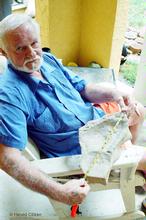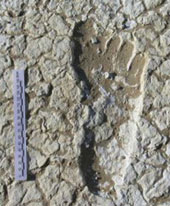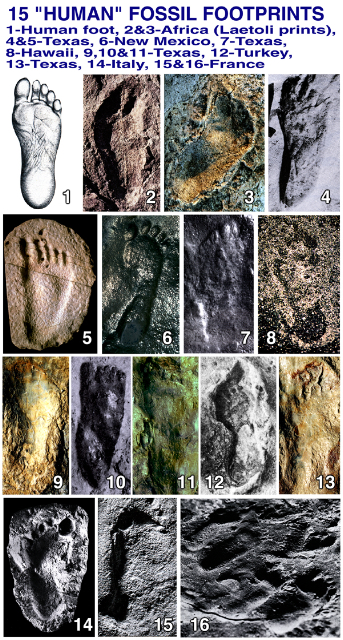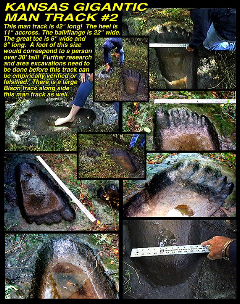
September 7, 2008

The Caney Fork River, Tennessee find.
Does anyone commenting on the so-called “fossilized Bigfoot track” know what he or she may be walking into? These are days of shooting fish in a barrel and any comment-maker better watch out that they don’t get hit from their blind side. The media are playing a strange game with “experts” they never have even talked to via a trap in Tennessee, and one that may be full of quicksand.
There seems to be a bit of nonsense coming from the Caney Fork River area, not so much from the folks down that way, but from what others who are reporting the news from there are saying.
People, from the media to others, have an agenda, and some people are getting caught up without looking at the greater context of where this might end.
First, a bit of background on the alleged series of footprints, which actually has only been shown to be one found “hominoid appearing imprint” from Tennessee.

Harold Jackson (above with track), an amateur archaeologist who enjoys collecting arrowheads and other Native American artifacts, of Cookeville, Tennessee, was strolling around his property along the Great Falls Lake above the Caney Fork River when he and a friend noticed an impression in a nearby rock.
“(My friend said) ‘That looks like a footprint.’ I had seen it before, but I didn’t think anything about it,” said Jackson. “But then when my friend said that, I got to looking at it, and sure enough, (I thought), ‘It’s got to be a footprint.'”
“Jackson pried the fossilized print up from the surrounding rock and brought it home. As he rinsed off the mud, he was impressed at the detail in the impression. Not only was the outline of the foot clear, but also the impression of the toes, the heal and the ball of the foot. Looking at it from the side, he could see where the weight of the walker had pressed the now hardened mud tightly together directly under the print, whereas the fossilized mud down deeper was not as closely packed. After studying it closely, Jackson is still unsure of what the footprint is from, but whatever it was, it was big,” wrote Megan Trotter a few days ago in the local Herald-Citizen.
Jackson was quoted as saying: “I don’t know anything about archaeology or anything, but if you look at it, it’s a footprint. No animal footprint looks like that. Now, if it’s a Native American, an Indian, then he was a big Indian. This [print] is 11 inches across and 15 inches (long). And my foot’s about four and a half by about 10….It’s got to be thousand of years old.”
Wait a second. Jackson is an amateur archaeologist who knows nothing about archaelogy? Yeah, right. Someone is pulling our collective leg, right? But is it Jackson or the media? Down home phrasing to get your guard down?
Since the time when these local reports began, the news has gotten bigger and bigger. Apparently not tired of Sasquatch stories, in the least, this small news item has morphed into a Bigfoot curiosity piece, being picked up across the Internet.
According to the press accounts, about half-a-dozen scientists said they want to look at the print, including Dr. Jeffrey Meldrum, “a famous Bigfoot professor at Idaho State University,” as he was called by the media. But is this a truthful comment by the media grounded in any reality?
Jackson said the print has made him a “believer in big foot” out there, which has been “heard” by some as him saying “Bigfoot,” especially when Jeff Meldrum’s name was thrown into this.
“It was just hard for me to believe. But listen, after I found this print, there’s a big foot [written as ‘Bigfoot’ in the print media] out there somewhere. I don’t know what kind of big foot [again, as ‘Bigfoot’ in print] it is, but there’s a big foot [‘Bigfoot’] out there somewhere,” said Jackson.
Again, what?
In a recent trip back to the site where the print came from, Jackson came across what he believes may be the print of the right foot. This one is fossilized in a much larger rock – one Jackson is unable to pull out. So for now it remains where he found it.
“I’m not wanting any credit or anything for it. I just found it and thought it might be interesting to the people to see this,” Jackson told one reporter. “I’ve never seen anything like it.”
Meldrum and Media Madness
“Channel 4 has yet to reach Meldrum or Tennessee state archaeologist Nick Fielder to comment on the artifact,” reported one local television station.
I really have resisted even mentioning this story at Cryptomundo for days, because it frankly felt like a non-story. Someone finds what looks like a footprint in a type of rock not identified and bad photos are displayed. I was waiting for a bit more.
But during this crazy summer, the story has now jumped all around, from maybe one of a Native American to Bigfoot to Meldrum’s name being mentioned.
Why?
For instance, I tend to agree with skeptic Zoo Knudsen on this one. He observed, in part, at his blog: “The report sinks even lower into pseudojournalism when it is revealed, as if it is in some way meaningful, that Channel 4 has yet to even speak with Meldrum, or to reach Tennessee state archaeologist Nick Fielder for comment on the footprint. It isn’t news that you didn’t talk to somebody. You don’t get credit for not doing your job when it comes to reporting. I have no doubt that lots of famous and important people are interested in whether or not Bigfoot exists, and many reputable scientists would be qualified to discuss this finding, but just mentioning the name of one is obviously thrown in to lend more credibility to this worthless bit of fluff.”
Exactly.
Knudsen tries to get downright funny when he points out that in spite of headlines like “Scientists Interested In Large Footprint Discovery”, that “the only scientist specifially named as being interested in the discovery is oft quoted Dr. Jeffrey Meldrum, whose skeptical take on the recent Bigfoot corpse hoax was paraded around the news circuit as if it was some kind of unique opinion that required being a ‘Bigfoot expert’ to hold.”
I think this is all unfair and unkind to Meldrum. He’s not been contacted by the media and he’s being used incorrectly in this article to support the Bigfoot angle, which he did not bring up and which I find is a misreading of what Jackson even said.
Late update: Indeed, in an email just received, Meldrum just wrote me: “One look at the accompanying photo and it is obviously not a real footprint, let alone a fossilized sasquatch print.”
Pseudofossils and Petrosomatoglyphs
Some footprints are not real, such as the following:

The deeper I dug into this Tennessee story, the more I wondered why it had become as big as it has.
What is really here, anyway? Has anyone writing on any of the many cryptozoology, Bigfoot, or Fortean sites, forums, and lists talking about this considered that what might be here is, well, nearly nothing?
Most people can understand the concept that some natural objects, such as crystal formations in rocks, look like fossils. Those are called pseudofossils.
But I don’t think that’s what is going on in Tennessee. What I found when I was studying archaeology in my undergrad days in southern Illinois is that carved footprints in stone are usually the source of these midwestern American reports. Now, I’m not saying this is the verdict on this Tennessee one, because, as far as I have been able to see, no one with any training has examined it and, like I mentioned, the photos are not great.
But what this “footprint” might be is a petrosomatoglyph. A petrosomatoglyph is an image of parts of a human or animal body incised in rock. The word comes from the Greek petros (“stone”), soma (“body”), and glyphein (“to carve”). Feet are the most common; however, knees, elbows, hands, head and fingers are also found.
“A set of Jesus’s footprints, according to legend, are preserved at the Church of Domine Quo Vadis outside of Rome. In Buddhist symbolism, a Buddhapada (footprint of the Buddha) with Dharmacakra and Triratna symbols from the 1st century, is to be found at Gandhāra, Northern Pakistan….Footprints of the Buddha also exist in Afghanistan, Bhutan, Cambodia, China, India, Japan, Korea, Laos, Malaysia, the Maldives, Pakistan, Singapore, and Burma,” helpfully lists Wikipedia.

“Danger ahead, Will Robinson.”
No, I am not saying any theorists are involved with this Tennessee print, yet. But there is a history here that people casually moving into this story must realize.

Rockcastle, Kentucky’s carved prints.
Real fossil footprints are often merged in with fake tracks to make some points.

In August 2006, some perfectly good news was announced from New South Wales, Australia, about 20,000-years-old footprints of five human hunters shown sprinting across the soft clay on the edge of a wetland. Real fossil footprints do exist. But they are frequently mixed in with others that are not.
Are there dangers for anyone wanting to talk about the story of this supposedly “fossil track” from Tennessee?

Unfortunately, the field of fossil footprints (carved, faked, even real and otherwise), in North America has often been politicalized, to serve as evidence of such things as the coexistence of humans and dinosaurs by a vocal minority, that the field of study is a mess, full of landmines.
Take, for example, the Omniology site, which has hoaxed pictures of “Civil War Pterodactyls” (that, of course, I know are fakes since I have a television prop example in my museum). The “omniologists” post their position that in various charts that all of the above and following are valid “fossil footprints,” to meet their own agenda.


Besides the “track” found in a rock in Tennessee, first off, not even being yet a verified fossil, let alone one of a Bigfoot, I would just caution anyone against being dragged into a cultural war in a border state over this one. Let us not cruise along as if all this talk of a “Bigfoot” fossil track is to be taken seriously.
What seems to have occurred is a jump in logic from a not-too-large impression in stone evolving quickly into a “fossilized Bigfoot track,” as a metaphoric cryptozoological form of Buddhapada, with no disrespect to Buddhists.
What this depression in a rock is, whether a carving or an actual imprint of a human, remains to be seen. That it has anything to do with Bigfoot appears to be one of the greatest stretches of imagination, however, since that unpleasantness in Georgia.

About Loren Coleman
Loren Coleman is one of the world’s leading cryptozoologists, some say “the” leading living cryptozoologist. Certainly, he is acknowledged as the current living American researcher and writer who has most popularized cryptozoology in the late 20th and early 21st centuries.
Starting his fieldwork and investigations in 1960, after traveling and trekking extensively in pursuit of cryptozoological mysteries, Coleman began writing to share his experiences in 1969. An honorary member of Ivan T. Sanderson’s Society for the Investigation of the Unexplained in the 1970s, Coleman has been bestowed with similar honorary memberships of the North Idaho College Cryptozoology Club in 1983, and in subsequent years, that of the British Columbia Scientific Cryptozoology Club, CryptoSafari International, and other international organizations. He was also a Life Member and Benefactor of the International Society of Cryptozoology (now-defunct).
Loren Coleman’s daily blog, as a member of the Cryptomundo Team, served as an ongoing avenue of communication for the ever-growing body of cryptozoo news from 2005 through 2013. He returned as an infrequent contributor beginning Halloween week of 2015.
Coleman is the founder in 2003, and current director of the International Cryptozoology Museum in Portland, Maine.
Filed under Artifacts, Bigfoot, Breaking News, Conspiracies, Cryptomundo Exclusive, Cryptotourism, CryptoZoo News, Evidence, Footprint Evidence, Fossil Finds